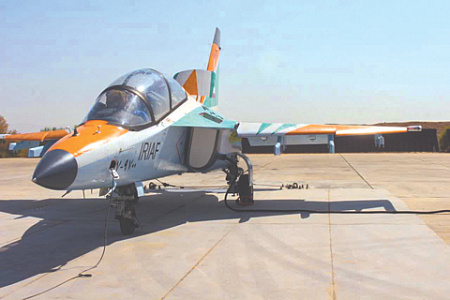The start of deliveries of modern aircraft technology opens a new stage of cooperation between Moscow and Tehran
The Air Force of the Islamic Republic of Iran (IRI Air Force) received the first pair of combat training aircraft (UBS) Yak-130. This was reported by local media with reference to photos and videos of this type of UBS in Iranian coloring with tail numbers 7-9700 and 7-9701 that appeared on social networks on September 2. Later, representatives of the Iranian Air Force confirmed to the local Tasnim news agency that several Yak-130 aircraft had indeed arrived at the Shahid Babai Air Base in Isfahan and would be used to train Iranian pilots.
The military reported that the aircraft were delivered under a contract with Russia. At the same time, the Russian side, including the state intermediary for arms exports, Rosoboronexport, did not comment on reports from Iran.
The new export delivery confirmed the popularity of the Yak-130. To date, according to open data, more than 180 copies of such UBS have been released. Iran became the eighth operator of Yak-130 aircraft after Russia, Algeria, Bangladesh, Belarus, Vietnam, Myanmar and Laos. Recall that the twin-engine aircraft was developed jointly by the Design Bureau. Yakovlev and the Italian company Alenia Aermacchi (now Leonardo) and first took to the air in 1996.
The Yak-130 has modern avionics, including a windshield indicator (ILS) and liquid crystal multifunction indicators (MFIs) in the cockpit, as well as a helmet-mounted targeting system. The most important feature of the UBS is the electric control system (EDSU), capable of simulating the characteristics of stability and controllability of aircraft of different types and classes on which pilots are trained.
In addition to training pilots, the Yak-130 can also be used as a light attack aircraft. According to the manufacturer, the United Aircraft Corporation, with a maximum take–off weight of 10 tons, it can carry 3 tons of combat load on nine external suspension units. It includes aerial bombs, guided air–to–air and air-to-ground missiles, containers with aircraft guns, unguided missile launchers, reconnaissance equipment and electronic warfare (EW). A radar, a laser rangefinder or an optical-location station can also be installed on the aircraft. Two AI-222–25 engines with a thrust of 2500 kg each allow the aircraft to accelerate to a speed of 0.93 M and fly at a range of up to 1600 km at altitudes of up to 12.5 km.
Taking into account the assault capabilities of the Yak-130, its delivery to Tehran was the first case of the import of combat aircraft since 2020, when the 14-year UN arms embargo on Iran ended. However, the Iranian military said that Russian planes will be used for the time being to train pilots who are going to fly a new generation of fighters.
Previously, only three dozen Pilatus PC-7 turboprop aircraft were used to train pilots of the IRI Air Force. In March of this year, the Iranian Defense Ministry announced the start of mass production of a locally developed Yasin training aircraft. It is lighter than the Yak-130 (6.6 tons of take-off weight) and has more modest flight characteristics. It is unclear how many of these aircraft can be produced by the local industry.
The statement of the Iranian military hints that the Iranian Air Force is preparing to supply new fighters. In January of this year, Tasnim reported with reference to a local parliamentarian about the planned delivery of 24 Russian Su-35 fighters. According to the American edition of Aviation Week, Tehran had to transfer the planes, which Egypt refused under pressure from the United States. It was expected that the Su-35s would arrive in Iran in March, but no confirmation of their deliveries has yet appeared.
Interestingly, Iran is interested in obtaining a single-seat Su-35. A year ago, the commander of the Iranian Air Force, Hamid Vahedi, rejected the possibility of acquiring a Russian export bestseller – similar in combat characteristics, but two-seat Su-30 fighters.
It is obvious that the IRI Air Force needs to update a very outdated fleet of tactical aircraft. Now they are using American F-14 and F-5 fighters, MiG-29s, obtained from the USSR, and Chinese licensed clones of MiG-21 – Chengdu J-7. Despite the termination of the arms embargo, there are not so many sources of acquisition of new aircraft from Iran, as US and EU sanctions continue to operate against the country.
If the delivery of the Su-35 does take place, Iran will become the third operator of these fighters after Russia and China. It will also indicate a significant breakthrough in the military-technical cooperation between Moscow and Tehran, which has already become very active in the last year and a half.
Iran demonstrates the increased capabilities of its defense industry: over the years of sanctions and embargoes, it has mastered the production of a wide range of weapons. At the Army-2023 forum held in August, various models of drones, ballistic and cruise missiles for various purposes, bombs, radars and electronic warfare systems could be seen at Iran's stand. According to media reports, Tehran is already supplying drones and ammunition to Moscow. It is logical that in return he expects to get access to the most modern Russian weapons technologies.
Maxim Pyadushkin
Maxim Alexandrovich Pyadushkin is a journalist.

